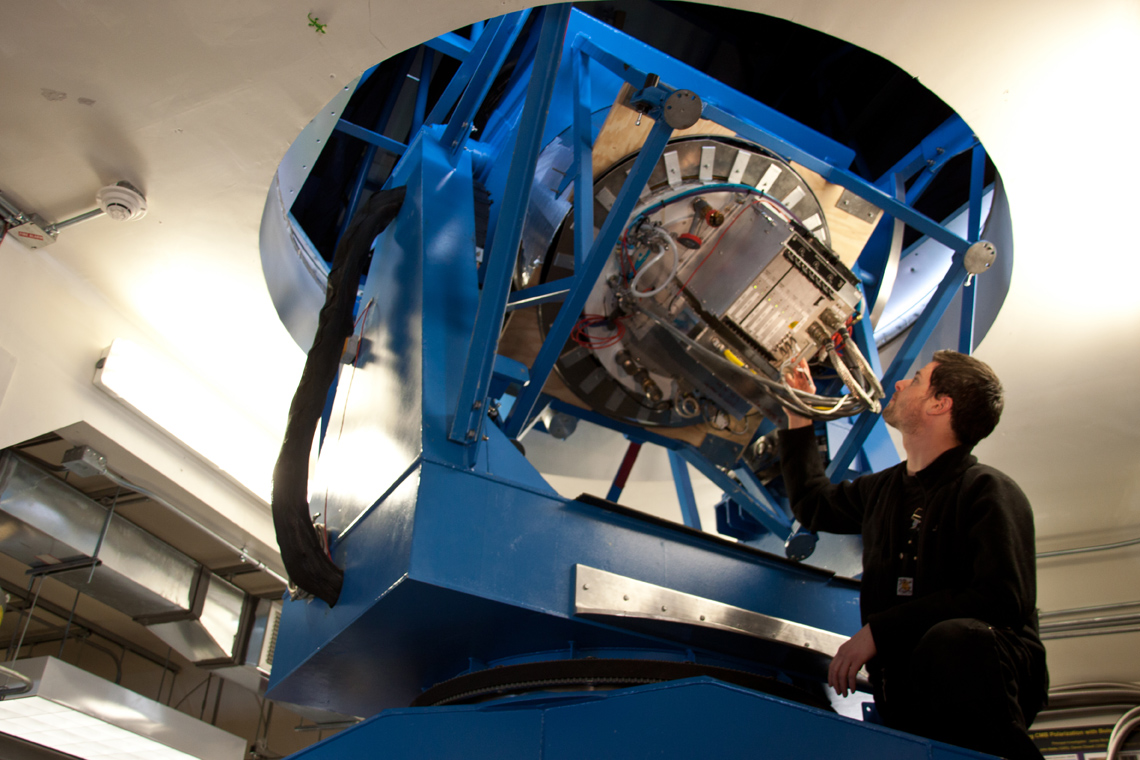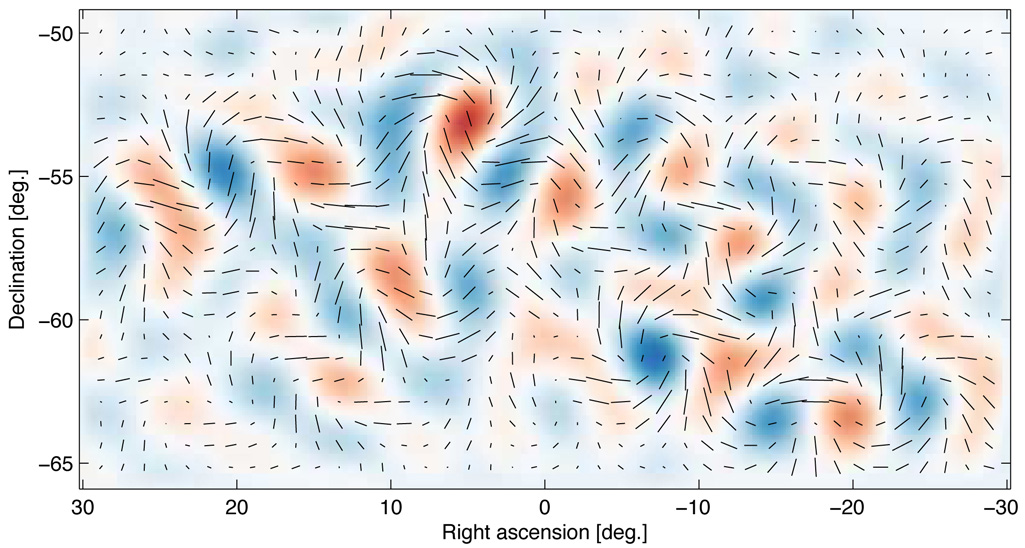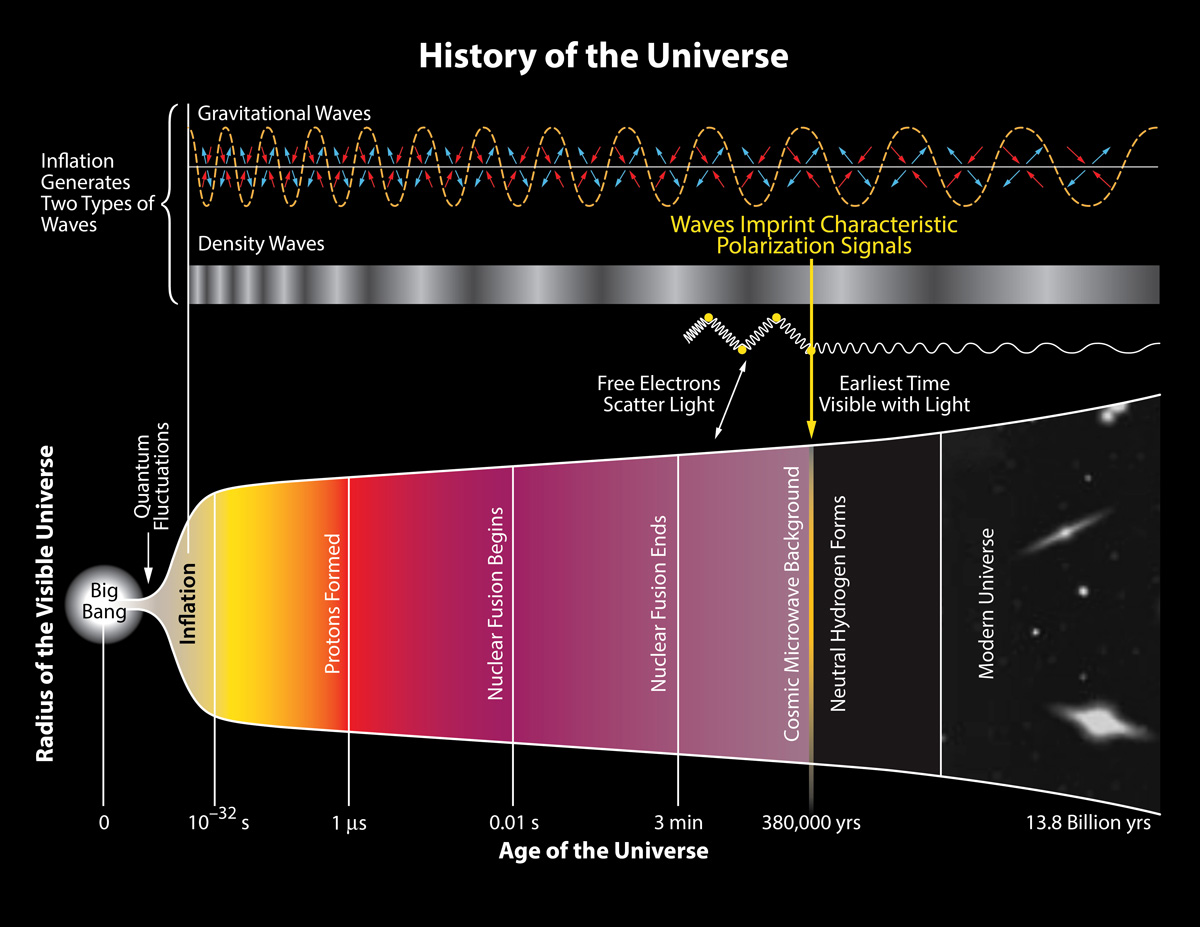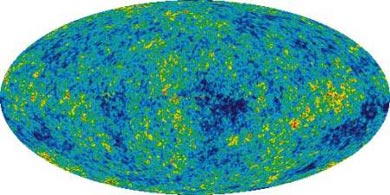First direct evidence of cosmic inflation
March 18, 2014

Graduate student Justus Brevik tests the BICEP2 telescope readout electronics (credit: Steffen Richter (Harvard University)
Researchers from the BICEP2 telescope collaboration announced Monday the first direct evidence for cosmic inflation.
The inflation theory posits that almost 14 billion years ago, the universe we inhabit burst into existence in an extraordinary event that initiated the Big Bang. In the first fleeting fraction of a second, the universe expanded exponentially, stretching far beyond the current view of our best telescopes.
Their data also represent the first images of gravitational waves, or ripples in space-time. These waves have been described as the “first tremors of the Big Bang.” Finally, the data confirm a deep connection between quantum mechanics and general relativity.
“Detecting this signal is one of the most important goals in cosmology today. A lot of work by a lot of people has led up to this point,” said John Kovac (Harvard-Smithsonian Center for Astrophysics), leader of the BICEP2 collaboration.
These groundbreaking results came from observations by the BICEP2 telescope (located at the South Pole) of the cosmic microwave background — a faint glow left over from the Big Bang and identical in all directions in the sky when viewed with a special microwave telescope.
Tiny fluctuations in this afterglow provide clues to conditions in the early universe. For example, small differences in microwave signal temperature across the sky show where parts of the universe were denser, eventually condensing into galaxies and galactic clusters.
Since the cosmic microwave background is a form of light, it exhibits all the properties of light, including polarization. On Earth, sunlight is scattered by the atmosphere and becomes polarized, which is why polarized sunglasses help reduce glare. In space, the cosmic microwave background was scattered by atoms and electrons and became polarized too.

Gravitational waves from inflation generate a faint but distinctive twisting pattern in the polarization of the cosmic microwave background, known as a “curl” or B-mode pattern. For the density fluctuations that generate most of the polarization of the CMB, this part of the primordial pattern is exactly zero. Shown here is the actual B-mode pattern observed with the BICEP2 telescope, which is consistent with the pattern predicted for primordial gravitational waves. The line segments show the polarization strength and orientation at different spots on the sky. The red and blue shading shows the degree of clockwise and anti-clockwise twisting of this B-mode pattern. (Credit: BICEP2 Collaboration)
“Our team hunted for a special type of polarization called ‘B-modes,’ which represents a twisting or ‘curl’ pattern in the polarized orientations of the ancient light,” said co-leader Jamie Bock (Caltech/JPL).
Gravitational waves squeeze space as they travel, and this squeezing produces a distinct pattern in the cosmic microwave background. Gravitational waves have a “handedness,” much like light waves, and can have left- and right-handed polarizations.
“The swirly B-mode pattern is a unique signature of gravitational waves because of their handedness. This is the first direct image of gravitational waves across the primordial sky,” said co-leader Chao-Lin Kuo (Stanford/SLAC).

Two types of waves generated by inflation and corresponding patterns in the CMBR (credit: BICEP2 Collaboration)
The team examined spatial scales (angles) on the sky spanning about one to five degrees (two to ten times the width of the full Moon). To do this, they traveled to the South Pole to take advantage of its cold, dry, stable air.
“The South Pole is the closest you can get to space and still be on the ground,” said Kovac. “It’s one of the driest and clearest locations on Earth, perfect for observing the faint microwaves from the Big Bang.”
They were surprised to detect a B-mode polarization signal considerably stronger than many cosmologists expected. The team analyzed their data for more than three years in an effort to rule out any errors. They also considered whether dust in our galaxy could produce the observed pattern, but the data suggest this is highly unlikely.
“This has been like looking for a needle in a haystack, but instead we found a crowbar,” said co-leader Clem Pryke (University of Minnesota).

History of the universe. Light from the Big Bang first became visible after 380,000 years (yellow arrow)(Credit: BICEP2 collaboration)
When asked to comment on the implications of this discovery, Harvard theorist Avi Loeb said, “This work offers new insights into some of our most basic questions: Why do we exist? How did the universe begin? These results are not only a smoking gun for inflation, they also tell us when inflation took place and how powerful the process was.”
BICEP2 is the second stage of a coordinated program, the BICEP and Keck Array experiments, which has a co-principal-investigator (PI) structure. The four PIs are John Kovac (Harvard), Clem Pryke (UMN), Jamie Bock (Caltech/JPL), and Chao-Lin Kuo (Stanford/SLAC). All have worked together on the present result, along with talented teams of students and scientists.
Other major collaborating institutions for BICEP2 include the University of California at San Diego, the University of British Columbia, the National Institute of Standards and Technology (NIST), the University of Toronto, Cardiff University, and Commissariat à l’Energie Atomique.
BICEP2 is funded by the National Science Foundation (NSF). NSF also runs the South Pole Station where BICEP2 and the other telescopes used in this work are located. The Keck Foundation also contributed major funding for the construction of the team’s telescopes. NASA, JPL, and the Moore Foundation supported the development of the ultra-sensitive detector arrays that made these measurements possible.
Technical details and journal papers can be found on the BICEP2 release website.
The Harvard-Smithsonian Center for Astrophysics (CfA) is a joint collaboration between the Smithsonian Astrophysical Observatory and the Harvard College Observatory. CfA scientists study the origin, evolution and ultimate fate of the universe.

